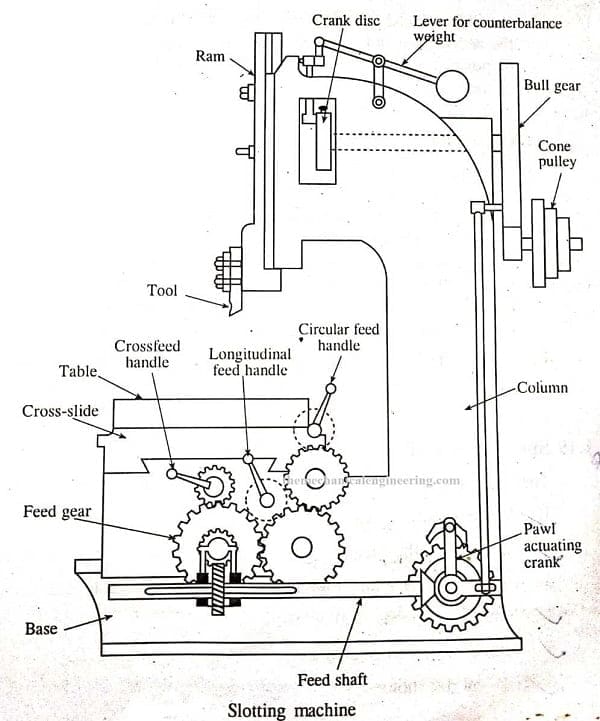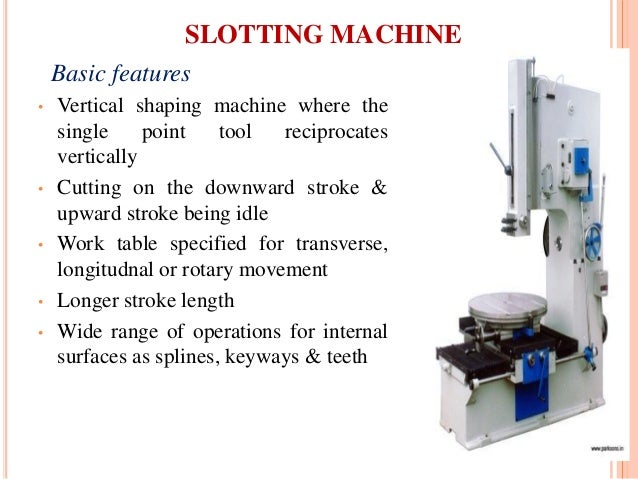- Shaper Machine – Types, Parts, Working, Operations, Diagram Horizontal Boring Machine – Parts, Working of Boring Machine Milling Machine – Types, Working, parts, Operations, Cutting parameter Slotter Machine Function -Types Of Slotting machine Shaper, Planer, Slotter machine Interview Question and Answers Difference Between Shaping.
- In this milling operation the cutter width extends beyond the workpiece on both sides. Slotting It is also a type of milling operation, also called as slot milling operation. In this case width of the cutter is less than the width of workpiece. It is used to make slot in the workpiece. Thin slots can be.
Explanation of how modern slot machine operates and understands the odds of playing slot machines. Virtually, anyone who visits a casino is familiar with a slot machine and how it operates, even a novice. You insert a coin, pull the handle or press a button and wait a few seconds to see if you win.
Different types of operations are performed in a shaping machine. They are broadly classified as
- Regular operations
- Special operations
Regular Operations
Machining Horizontal Surfaces
A shaper is mostly used to machine a flat, true surface on a workpiece. Horizontal surfaces are machined by moving the work mounted on the machine table at a cross direction with respect to the ram movement. The clapper box can be set vertical or slightly inclined towards the uncut surface. This arrangement enables the tool to lift automatically during the return stroke. The tool will not drag on the machined surface.
MachiningVerticalSurfaces
A vertical cut is made while machining the end of a workpiece, squaring up a block or machining a shoulder.
The feed is given to the tool by rotating the downfeed screw of the vertical slide. The table is not moved vertically for this purpose. The apron is swiveled away from the vertical surface being machined as shown in the diagram.
Machining AngularSurfaces

If the surface to be machined is neither horizontal nor perpendicular, the surface is called inclined surface. Machining ‘V’ grooves and dovetail grooves are some examples for angular machining.
Machining the inclined (angular) surfaces can be done in several ways. They are
- Taper strip method – The taper strip is positioned on the table and fixed. On the taper strip, the job is fixed and machined. The angular surface is obtained.
- Layout method – Slanting surface is marked on the work piece. The job is positioned by suitable arrangement in such a way that the marked line is either horizontal or vertical. If the machining is carried out, the required angular surface is obtained.
- Degree parallel method – Degree parallel block is a wedge shaped precision block for a particular angle. The degree parallel block is placed first on the table. Over and above that, the workpiece is positioned and the machining is done as usual to obtain the required angular surface.
- Universal vice method – The job may be fixed in the universal vice and then the vice is swiveled to the required angular position. If the machining is carried out, the required slanting (angular) surface will be obtained.
- Universal table method – If the universal table is available in the shaping machine, then the table can be tilted to the required position and the work is fitted on that. The machining is done as usual to obtain the required angular surface.
- Swivel toolhead method – An angular cut is made at any angle other than a right angle to the horizontal or to the vertical plane. The work is set on the table and the vertical slide of the toolhead is swiveled to the required angle either towards left or towards right from the vertical position. The apron is then further swiveled away from the work to be machined.
Special Operations
Apart from machining horizontal, vertical and vertical flat surfaces, the shaping machine can do some special machining operations.
Machiningdovetailgroove
Dove tail joint is machined on two separate pieces of work as male and female elements. The required shape is marked on the face of the work and the unwanted metal is first removed by the round nose tool. A special form tool is used to finish the machining.
Machininga ‘V’ block
The required shape of a ‘V’ block is marked on the face of the work and machining is done by any suitable method of angular machining.
Machininga tongue and groove joint
The male and female elements of the tongue and groove joint having vertical surfaces is machined after the exact shape is marked on the face of the work.
MachiningExternalKeyways
Machining external keyways refers to the cutting of long slots along the length of cylindrical rods. Initially a round nose tool is used and then a square nose tool is used to finish the operation. A hole of depth equal to the depth of the keyway is made at the blind end to leave a clearance to the tool at the end of the stroke. When a keyway is cut at the middle of the shaft, holes are drilled at both ends of the keyway.
Slotting Machine Operation Ppt Template

MachiningInternalKeyways
Internal keyways are cut inside the holes of gears and pulleys. It is done by holding the tool on a special tool holder called ‘snout bar’. The snout bar is directly fitted on the the clapper block.
Cnc Slotting Machine
T-slot Machining
The shape of the T-slot is marked on the face of the work. A parting off tool is fitted on the toolpost and a rectangular slot is machined at the middle for the required depth. The broad base of the ‘T’ slot is machined by a T-slot cutting tool.
Machininga Rack Gear
Rack gear cutting is a process of cutting teeth elements at linear pitch on a flat piece of work. Firstly, the groove is machined with a square nose parting tool. Then, the groove is further machined with a form tool conforming the shape of the teeth.
Slotting Machine Operation Ppt Presentation
MachiningIrregularSurfaces
A shaper can also produce a contoured surface using a round nose tool. To produce a small contoured surface a forming tool is used. If the curve is sufficiently large, powered crossfeed along with manual down feed is so adjusted that the tool will trace the required contour.